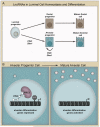Noncoding RNAs involved in mammary gland development and tumorigenesis: there's a long way to go
- PMID: 22402938
- PMCID: PMC3637027
- DOI: 10.1007/s10911-012-9247-3
Noncoding RNAs involved in mammary gland development and tumorigenesis: there's a long way to go
Abstract
The mammalian genome encodes thousands of noncoding RNAs. These noncoding transcripts are broadly categorized into short noncoding RNAs, such as microRNAs (miRNAs), and long noncoding RNAs (lncRNAs) of greater than 200 nt. While the role of miRNAs in development and cancer biology has been extensively studied, much less is known about the vast majority of noncoding transcripts represented by lncRNAs. LncRNAs are emerging as key regulators of developmental processes and as such, their frequent misregulation in tumorigenesis and disease in not unexpected. The role of lncRNAs in mammary gland development and breast cancer is just beginning to be elucidated. This review will discuss the role of lncRNAs in mammalian and mammary gland development. In addition, we will review the contributions of lncRNAs to the stepwise progression of tumorigenesis, highlighting the role of lncRNAs in breast cancer.
Figures

Similar articles
-
Non-coding RNAs as regulators of mammary development and breast cancer.J Mammary Gland Biol Neoplasia. 2012 Mar;17(1):33-42. doi: 10.1007/s10911-012-9245-5. Epub 2012 Feb 17. J Mammary Gland Biol Neoplasia. 2012. PMID: 22350981 Free PMC article. Review.
-
Small non-coding RNAs govern mammary gland tumorigenesis.J Mammary Gland Biol Neoplasia. 2012 Mar;17(1):59-64. doi: 10.1007/s10911-012-9246-4. Epub 2012 Mar 1. J Mammary Gland Biol Neoplasia. 2012. PMID: 22382486 Free PMC article. Review.
-
Mammary gland development & breast cancer; connecting the dots by non-coding RNAs.J Mammary Gland Biol Neoplasia. 2012 Mar;17(1):1-2. doi: 10.1007/s10911-012-9248-2. J Mammary Gland Biol Neoplasia. 2012. PMID: 22402939 Free PMC article. No abstract available.
-
Noncoding RNAs in breast cancer.Brief Funct Genomics. 2016 May;15(3):200-21. doi: 10.1093/bfgp/elv055. Epub 2015 Dec 18. Brief Funct Genomics. 2016. PMID: 26685283 Free PMC article. Review.
-
Non-coding RNAs in Mammary Gland Development and Disease.Adv Exp Med Biol. 2016;886:121-153. doi: 10.1007/978-94-017-7417-8_7. Adv Exp Med Biol. 2016. PMID: 26659490 Review.
Cited by
-
Long-term exposure of MCF-7 breast cancer cells to ethanol stimulates oncogenic features.Int J Oncol. 2017 Jan;50(1):49-65. doi: 10.3892/ijo.2016.3800. Epub 2016 Dec 9. Int J Oncol. 2017. PMID: 27959387 Free PMC article.
-
Mammary Tumor-Associated RNAs Impact Tumor Cell Proliferation, Invasion, and Migration.Cell Rep. 2016 Sep 27;17(1):261-274. doi: 10.1016/j.celrep.2016.08.081. Cell Rep. 2016. PMID: 27681436 Free PMC article.
-
Insights from Global Analyses of Long Noncoding RNAs in Breast Cancer.Curr Pathobiol Rep. 2017 Mar;5(1):23-34. doi: 10.1007/s40139-017-0122-1. Epub 2017 Jan 23. Curr Pathobiol Rep. 2017. PMID: 28616363 Free PMC article.
-
Long non-coding RNA DUXAP8 promotes the cell proliferation, migration, and invasion of papillary thyroid carcinoma via miR-223-3p mediated regulation of CXCR4.Bioengineered. 2021 Dec;12(1):496-506. doi: 10.1080/21655979.2021.1882134. Bioengineered. 2021. PMID: 33522355 Free PMC article.
-
Long-term exposure of MCF-12A normal human breast epithelial cells to ethanol induces epithelial mesenchymal transition and oncogenic features.Int J Oncol. 2016 Jun;48(6):2399-414. doi: 10.3892/ijo.2016.3461. Epub 2016 Mar 29. Int J Oncol. 2016. PMID: 27035792 Free PMC article.
References
-
- Katayama S, Tomaru Y, Kasukawa T, Waki K, Nakanishi M, Nakamura M, et al. Antisense transcription in the mammalian transcriptome. Science. 2005;309(5740):1564–6. doi:10.1126/science.1112009. - PubMed
-
- Carninci P, Kasukawa T, Katayama S, Gough J, Frith MC, Maeda N, et al. The transcriptional landscape of the mammalian genome. Science. 2005;309(5740):1559–63. doi:10.1126/science.1112014. - PubMed
-
- Bertone P, Stolc V, Royce TE, Rozowsky JS, Urban AE, Zhu X, et al. Global identification of human transcribed sequences with genome tiling arrays. Science. 2004;306(5705):2242–6. doi:10.1126/science.1103388. - PubMed
-
- Cheng J, Kapranov P, Drenkow J, Dike S, Brubaker S, Patel S, et al. Transcriptional maps of 10 human chromosomes at 5-nucleotide resolution. Science. 2005;308(5725):1149–54. doi:10.1126/science.1108625. - PubMed
Publication types
MeSH terms
Substances
Grants and funding
LinkOut - more resources
Full Text Sources
Other Literature Sources
Medical
Research Materials

